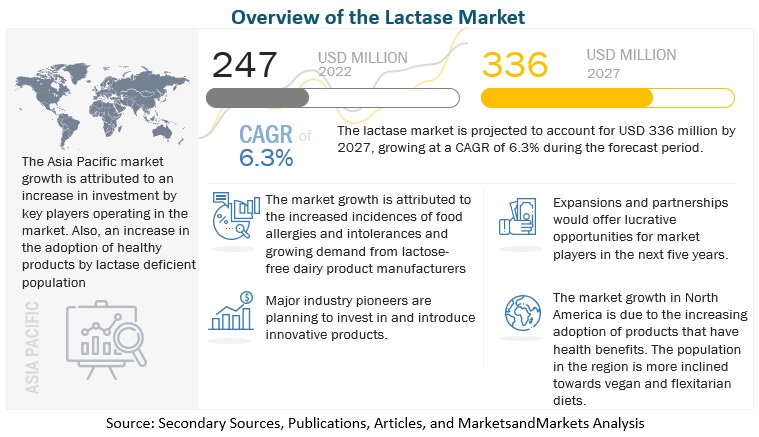The lactase market is estimated to be valued at USD 217 million in 2020 and is projected to reach USD 298 million by 2025, recording a CAGR of 6.5 %, in terms of value. Factors such as rising cases of lactose-intolerant and growing demand from lactose-free dairy product manufacturers and increasing innovation and new product development in the application areas are projected to drive the growth of the lactase industry during the forecast period. However, the growth of the market is inhibited by factors, such as shifting preferences toward dairy-free alternatives and high processing cost and lack of technical expertise for lactase extraction.
Market Dynamics
Drivers: Rising cases of lactose-intolerance and growing demand from lactose-free dairy product manufacturers
Lactase enzyme find its major applications in the food & beverage industry, majorly for dairy products, as it reduces the lactose content and makes the products lactose-free. The rise in lactose intolerant population globally is one of the major factors driving the growth of lactase market, which is used in the production of lactose-free dairy products.
The demand for lactose-free dairy food products is driven by the increase in incidences of food allergies and intolerances. Lactase converts the milk sugar found in dairy products, such as milk, ice cream, and cheese, to readily digestible sugars, such as glucose and galactose. Without adequate lactase, the lactose in food ferments in the intestine produces undesirable side effects. In addition, the increase in health awareness and wellness concerns among consumers is a key factor that is projected to drive the growth and demand for lactose-free dairy products.

Restraints: Shifting preferences toward dairy-free alternatives
In recent years, plant sources such as legumes and cereals have been highly accepted as functional food and nutraceuticals because of the health promoting components present in them such as minerals, dietary fibers, antioxidants and vitamins. Owing to these benefits over dairy products, the demand for plant-based dairy is increasing. The rising opportunity in the dairy free sector is restraining the growth of lactose-free dairy products, which can be a one of the restraints for the lactase enzyme, as it is the prime raw material used for processing regular dairy products into lactose-free dairy products.
Opportunities: Research & development and new sources of lactase extraction
Lactase is usually extracted from yeast. However, an extensive research & development is going on regarding the other sources of lactase enzymes, such as bacteria and fungi. Lactase enzymes extracted from bacterial sources have been used for lactose hydrolysis because of numerous benefits, such as their ease of fermentation, high activity, and the stability of the enzyme. Lactase enzymes sourced from a probiotic organism are used for food and food systems. Fungal sources of lactase enzymes possess optimal acidic pH range of 2.2 to 5.4. Owing to this, lactase sourced from fungi are more effective for the hydrolysis of lactose found in acidic substances, such as whey. These fungi-based enzymes are highly stable enzymes. The increasing research & developments about various sources of lactase enzymes gives opportunity to the lactase enzyme market to grow in the period forecasted.
Challenges: High processing cost and lack of technical expertise for lactase extraction
Small & medium-sized enterprises have efficient cost management due to limited capital and resources. Many quality and productivity improvement techniques are generally not finding a place in SMEs (small-and medium-sized enterprises) due to the lack of knowledge and resources to implement the same. However, the high costs involved in adapting to new technologies, production, and extraction procedures have restricted SMEs from improving their operations. Moreover, the process of lactase extraction requires technical expertise and abundant knowledge, which is majorly not present with the SMEs. Thus, extraction of lactase enzymes with fully equipped knowledge and expertise is among the major challenges for the lactase enzyme market.